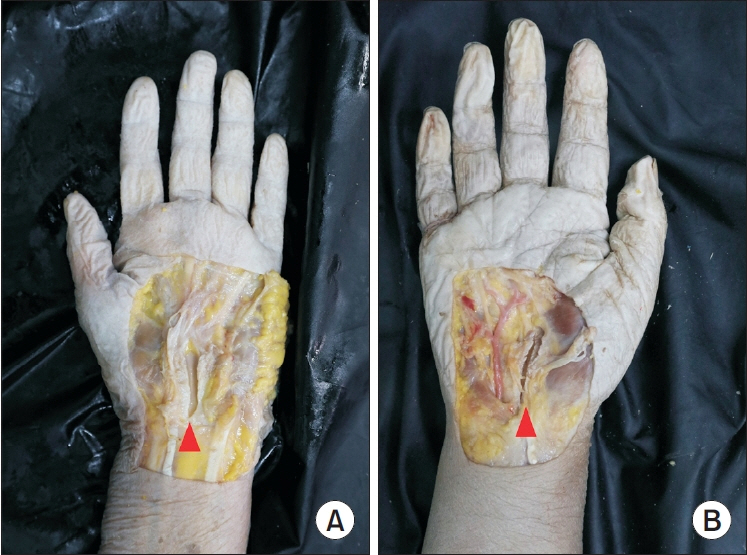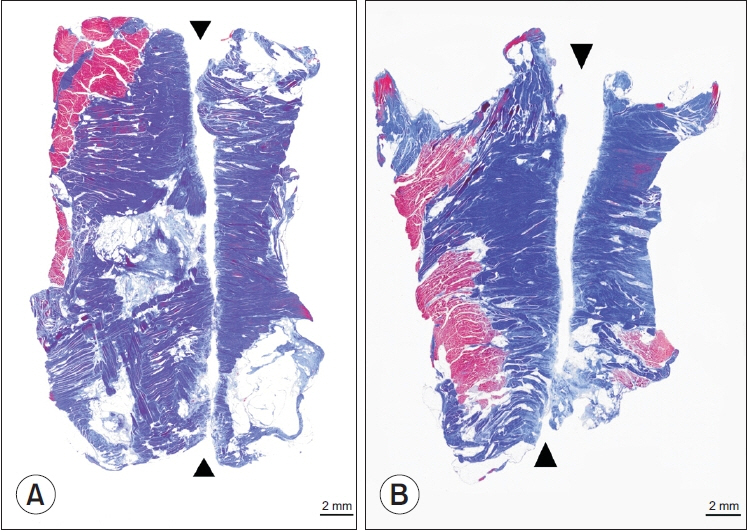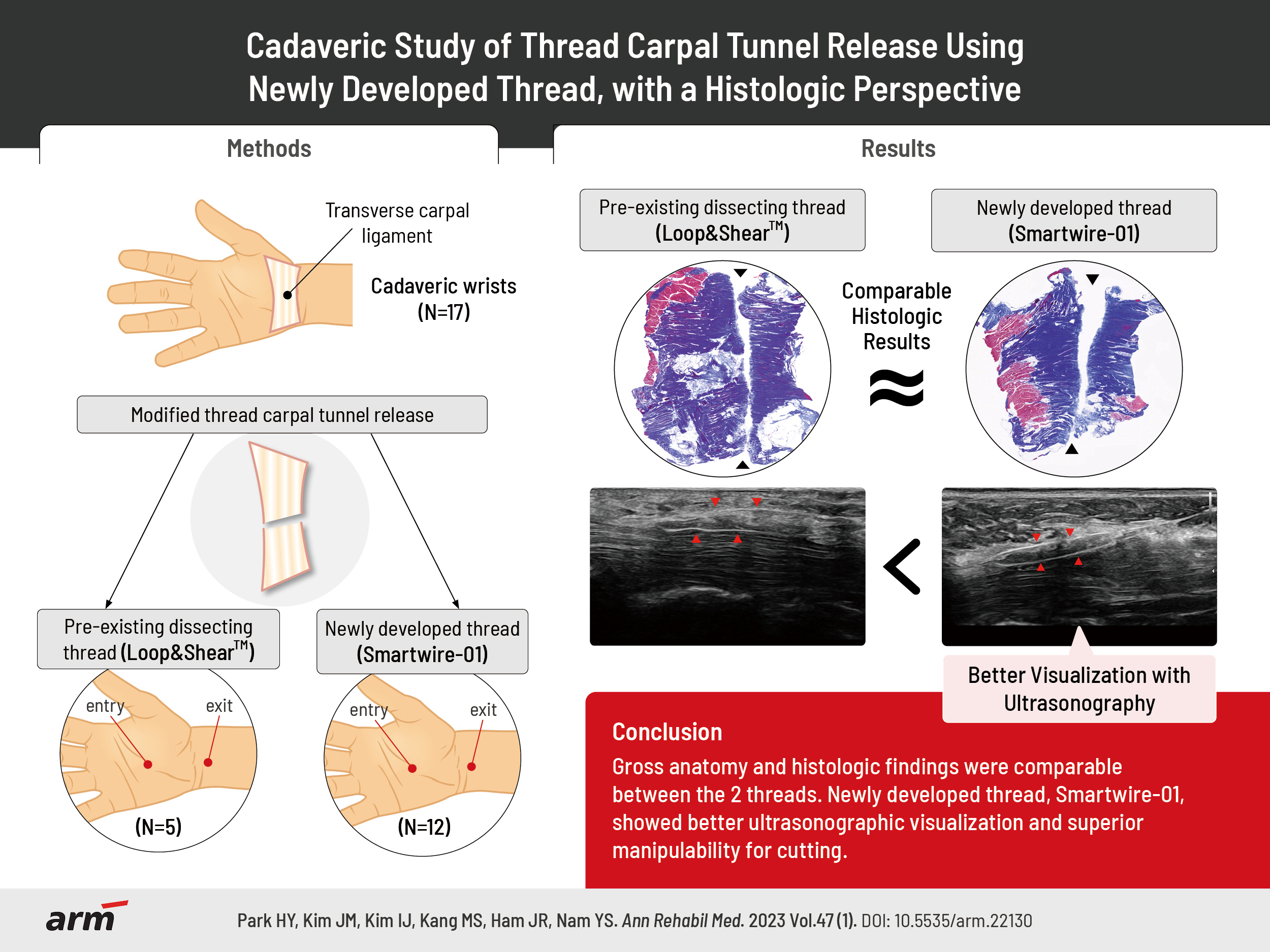Ann Rehabil Med.
2023 Feb;47(1):19-25. 10.5535/arm.22130.
Cadaveric Study of Thread Carpal Tunnel Release Using Newly Developed Thread, With a Histologic Perspective
- Affiliations
-
- 1Department of Rehabilitation Medicine, Seoul St. Mary’s Hospital, College of Medicine, The Catholic University of Korea, Seoul, Korea
- 2Department of Rehabilitation Medicine, Incheon St. Mary’s Hospital, College of Medicine, The Catholic University of Korea, Seoul, Korea
- 3Department of Rehabilitation Medicine, Howareyou Rehabilitation Clinic, Seoul, Korea
- 4Department of Research & Development, Ultra V Co. Ltd., Seoul, Korea
- 5Department of Anatomy, College of Korean Medicine, Dongshin University, Naju, Korea
- KMID: 2539724
- DOI: http://doi.org/10.5535/arm.22130
Abstract
Objective
To examine the usefulness and feasibility of modified thread carpal tunnel release (TCTR) by comparing the results of using pre-existing commercial thread with those of a newly developed thread (Smartwire-01).
Methods
A total of 17 cadaveric wrists were used in the study. The modified TCTR method was practiced by two different experts. Pre-existing commercial surgical dissecting thread (Loop&ShearTM) was used for five wrists and the newly developed Smartwire-01 was used for twelve wrists. The gross and microanatomy of the specimens were evaluated by a blinded anatomist.
Results
Both types of thread were able to cut the TCL similarly. Gross anatomy and histologic findings showed that there was no significant difference between the two types of threads. However, the practitioners felt that it was easier to cut the TCL using the newly-developed thread.
Conclusion
TCTR using Smartwire-01 was as effective as pre-existing Loop&ShearTM, with better user experiences.
Keyword
Figure
Reference
-
1. Atroshi I, Gummesson C, Johnsson R, Ornstein E, Ranstam J, Rosén I. Prevalence of carpal tunnel syndrome in a general population. JAMA. 1999; 282:153–8.2. Padua L, Coraci D, Erra C, Pazzaglia C, Paolasso I, Loreti C, et al. Carpal tunnel syndrome: clinical features, diagnosis, and management. Lancet Neurol. 2016; 15:1273–84.3. Jeong YH, Choi JH, Choi HS, Kang S, Yang SN, Yoon JS. Risk assessment of injury to palmar cutaneous branch of the median nerve using high-resolution ultrasound. Ann Rehabil Med. 2019; 43:458–64.4. Marshall S, Tardif G, Ashworth N. Local corticosteroid injection for carpal tunnel syndrome. Cochrane Database Syst Rev. 2007; (2):CD001554.5. O’Connor D, Marshall S, Massy-Westropp N. Nonsurgical treatment (other than steroid injection) for carpal tunnel syndrome. Cochrane Database Syst Rev. 2003; 2003:CD003219.6. Page MJ, Massy-Westropp N, O’Connor D, Pitt V. Splinting for carpal tunnel syndrome. Cochrane Database Syst Rev. 2012; 2012:CD010003.7. Page MJ, O’Connor D, Pitt V, Massy-Westropp N. Therapeutic ultrasound for carpal tunnel syndrome. Cochrane Database Syst Rev. 2013; 2013:CD009601.8. Kim DH, Cho BM, Oh SM, Park DS, Park SH. Delayed improvement after endoscopic carpal tunnel release. J Korean Neurosurg Soc. 2014; 56:390–4.9. Li Y, Luo W, Wu G, Cui S, Zhang Z, Gu X. Open versus endoscopic carpal tunnel release: a systematic review and meta-analysis of randomized controlled trials. BMC Musculoskelet Disord. 2020; 21:272.10. Guo D, Tang Y, Ji Y, Sun T, Guo J, Guo D. A non-scalpel technique for minimally invasive surgery: percutaneously looped thread transection of the transverse carpal ligament. Hand (N Y). 2015; 10:40–8.11. Guo D, Guo D, Guo J, Schmidt SC, Lytie RM. A clinical study of the modified thread carpal tunnel release. Hand (N Y). 2017; 12:453–60.12. Guo D, Guo D, Guo J, Malone DG, Wei N, McCool LC. A cadaveric study for the improvement of thread carpal tunnel release. J Hand Surg Am. 2016; 41:e351. –7.13. Jones NF, Ahn HC, Eo S. Revision surgery for persistent and recurrent carpal tunnel syndrome and for failed carpal tunnel release. Plast Reconstr Surg. 2012; 129:683–92.14. Jansen MC, Duraku LS, Hundepool CA, Power DM, Rajaratnam V, Selles RW, et al. Management of recurrent carpal tunnel syndrome: systematic review and meta-analysis. J Hand Surg Am. 2022; 47:388.e1–388.e19.15. Kilinc F, Behmanesh B, Seifert V, Marquardt G. Does recurrence of carpal tunnel syndrome (CTS) after complete division of the transverse ligament really exist? J Clin Med. 2021; 10:4208.
- Full Text Links
- Actions
-
Cited
- CITED
-
- Close
- Share
- Similar articles
-
- A Cadaveric Study of Thread Cubital Tunnel Release with Newly Developed Threads
- Ultrasound-Guided Minimally Invasive Procedure Using Thread
- Does Aging Matter? The Efficacy of Carpal Tunnel Release in the Elderly
- Change of Pillar Pain after Endoscopic Carpal Tunnel Release
- Comparison of Clinical Results of Minimal Incision Versus Endoscopic Carpal Tunnel Release







